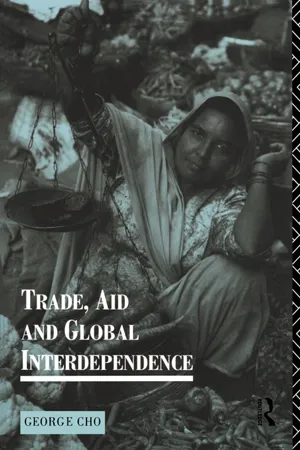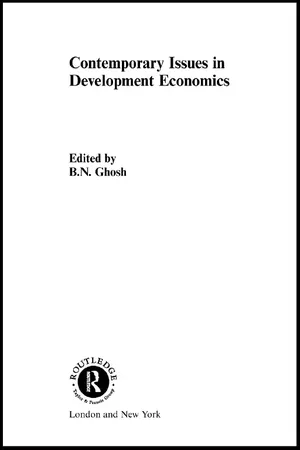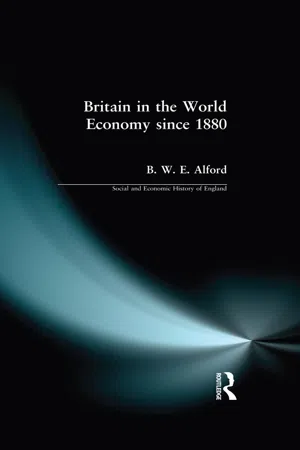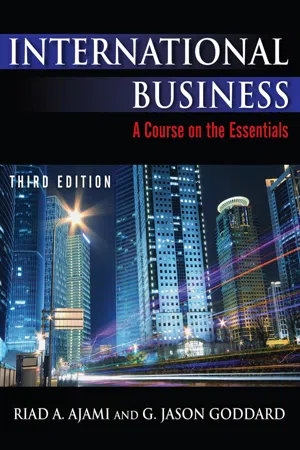Economics
Patterns of world trade
Patterns of world trade refer to the recurring trends and characteristics of international trade flows between countries. These patterns are influenced by factors such as comparative advantage, specialization, and trade agreements. They can also be shaped by global economic conditions, technological advancements, and government policies. Understanding these patterns is crucial for analyzing the dynamics of global trade and its impact on economies.
Written by Perlego with AI-assistance
Related key terms
6 Key excerpts on "Patterns of world trade"
- eBook - ePub
- George Cho(Author)
- 2008(Publication Date)
- Routledge(Publisher)
Ron Johnston (1967) proposed a simple framework to discuss international trade patterns as a spatial system having three interacting components in which the system operates. First, there is a set of fixed elements which is characterized by certain attributes. These elements and attributes can be thought of as countries and economic production respectively. Then there is a set of relationships or interactions between the fixed elements. These linkages are established through formal links such as laws, contracts and understandings and through established structures such as physical transport and delivery, payment mechanisms and the resolution of disputes. The third set of relationships are those which connect the fixed elements with their external environment and other elements of the larger system. This framework gives structure to the system and also includes the notion of a causal system in which one element may cause another to respond in a particular way.There have been many attempts to put these simple ideas into a workable scheme but no easy solution has been found. A consignment of goods threads a maze of great complexity. While it may be easy to think of international trade as an exchange between countries and economies, this simple view is inaccurate. Trade data of market economies represent the aggregation of countless individual transactions of exports and imports. In the command economies of socialist countries, state trading and government monopolies determine the volume of imports and exports. In between these extremes of economic organization are intermixed a myriad of private and public transactions.The present task therefore is to map out international trade to detect geographical patterns. Previous discussions have suggested that the level of economic development may be a major determinant of the pattern of international trade with the hint that the geographical distance between potential trade partners may be a conditioning variable. Also it seems that developed economies are far more important for the developing world than the other way round. However, with the globalization of national economies such a notion may no longer be wholly true. A lack of trade between developing economies, the predetermined composition of goods exported and the physical transport network between two countries may increase the relative bargaining position of developing countries. Thus, it is imperative that the geographical pattern of international trade be described simply. One suggestion is to examine the geographical distribution of exports and imports, and then the commodity distribution of exports and imports – the basic ‘who’ and ‘what’ questions. Such a description is prompted by the stability in the patterns of international trade flows since the Second World War, despite the massive growth in the volume of world trade of about 25 times, and the dramatic change in trade patterns of individual commodities, such as petroleum and industrial raw materials, to counter declines in the movement of traditional energy goods. The changes in transport technology and the downturn in the trade for food items because of self-sufficiency, substitution of products and growth of manufacturing industries, may be contrasted with the growth of high-value, low-density commodities associated with the electronics and information-based industries. - eBook - ePub
The North American Trajectory
Cultural, Economic, and Political Ties among the United States, Canada and Mexico
- Neil Nevitte(Author)
- 2017(Publication Date)
- Routledge(Publisher)
Changing Patterns of world trade and Changing North American LinkagesChanging Patterns of world trade
Since the Second World War, the General Agreement on Tariffs and Trade (GATT) has provided the framework for regularizing the multilateral trading practices of most advanced industrial states. In a series of agreements, starting with the Geneva talks of the 1940s and including the Tokyo and Kennedy rounds of the 1960s and 1970s, major trading nations negotiated massive reductions in tariffs on manufactured goods. On average, tariffs fell from about 40 percent to about 5 percent. That trade liberalization, coupled with the development of fully convertible currencies and the emergence of effective machinery for managing international exchange, encouraged a remarkably rapid expansion in world trade. Between 1950 and 1975, global output increased by some 200 percent, while the volume of trade expanded by about 500 percent. In one spurt, starting in the mid-1960s, the exports of advanced industrial states grew 80 percent faster than industrial production—a rate that was about twice as fast as the expansion of the GDP (Stewart 1984).By most benchmarks, GATT's performance in promoting freer trade through multilateral negotiation has been an enormous success, particularly during its first twenty-five years. But further progress toward multilateral trade liberalization started to lose momentum by the 1970s and the Uruguay round, which began in 1986, appeared to have completely stalled by 1990. Two broad recent trends are noteworthy. First, since the 1970s, major trading nations have increasingly resorted to a variety of protectionist strategies including import and export restraints, antidumping safeguards, countervailing duties, price fixing, and the use of informal and formal quotas. This shift from "open" to "managed" trade has been accompanied by a shift from multilateral trading patterns to the formation of regional groupings. The European Union has emerged as the most coherent trading bloc in the world; it has, by far, the largest volume of internal trade and its potential to play a dominant role in the world economy has been further accelerated by the restructuring of Eastern Europe and the reunification of Germany. The Asia- Pacific region, particularly Japan and the Four Little Dragons—South Korea, Taiwan, Singapore, and Hong Kong—forms a second even more dynamic, though less coherent network. North America represents a potential counterweight to them (see Figure 2.1). - eBook - ePub
- B. N. Ghosh(Author)
- 2001(Publication Date)
- Routledge(Publisher)
7 The pure theory of international trade, globalization, growth and sustainable development: Agenda for the future
M.R. Aggarwal
Introduction: the historical perspective
The pure theory of international trade, as expounded by classical, neoclassical, and modern economists, seeks to provide an explanation of the factors, originating both from demand and supply side which tend to influence the observed pattern of trade flows and specialization among nations, and their welfare implications measured in terms of Pareto optimality, for each of the trading partners and for the world as a whole. The principle of comparative advantage was developed by Torrens (1808) and used by Ricardo (1817) to explain the pattern of trade and the benefits flowing from free trade and competition. Ricardo argues that trade between countries arises because of the relative differences in the pre-trade prices of the goods, on the assumption that the relative production costs of goods and hence relative prices (PX /PY ) in a closed economy, under competitive equilibrium conditions in both commodity and factor markets and a simple production function with the single input and constant returns, are entirely determined by relative labour inputs (LX /LY ), i.e.:and the differences in the pre-trade domestic price ratios of the goods and the comparative advantage and disadvantage, in costs between countries will be mainly due to differences in relative labour productivity. The theory assumes, among other things, immobility of the factors of production internationally, with negligible transport costs, and unchanged technology, factor inputs and demand patterns. - eBook - ePub
Globalization
Education Research, Change and Reform
- Zygmunt Bauman, Michael Weinstein, Nicholas Sun-keung Pang(Authors)
- 2005(Publication Date)
- Columbia University Press(Publisher)
Globalization and Patterns of Economic GrowthJEFFREY D. SACHST HIS CHAPTER EXPLORES cross-country patterns of growth in the era of globalization—specifically, during 1980–98, a period in which world trade and financial flows increased enormously, more rapidly than economic output. I’ll argue that the world economy is divided between a “core” that is characterized by self-driven (or endogenous) economic growth, and the rest of the world, whose long-term growth depends on the economic linkages with the core. These linkages are influenced not only by institutional characteristics that economists have long studied (such as openness of trade and protection of property rights) but also by physical endowments and geography.In studying the growth of the non-core economies during 1980–98, I’ve found that rapid growth was associated with some simple population patterns, including a large population, a high proportion of the population near the coast, and a low proportion of the population in regions of malaria transmission. I’ve also found that non-core economies have benefited from government policies aimed specifically at promoting science and technology. I conclude with a brief description of the policy implications of these findings, and some suggestions as to what the developed nations can do to help more developing nations benefit from stronger economic growth in the years to come.WHY GROWTH RATES DIFFERDuring the past two decades, globalization has been fueled by technology (especially the falling costs of transportation, communication, and information processing) as well as by the political and economic choices of national governments (notably through liberalization of trade policy, the dismantling of socialist development models, and the growth of international institutions such as the World Trade Organization). As a result, most of the world is increasingly integrated in a global market system. But economic performance has varied greatly from country to country, with developing countries struggling in particular. - eBook - ePub
- Bernard W.E. Alford(Author)
- 2014(Publication Date)
- Routledge(Publisher)
Among the large economies the USA and Germany achieved particularly high rates of growth, whilst Belgium and Switzerland are prime examples of what could be achieved by small nations. Correspondingly, there were major changes in national shares of world trade. For the UK the outcome was a marked decline in its relative standing. Whether this represented a degree of failure or whether it should be regarded as a natural and direct consequence of world economic expansion is the issue on which the analysis will now focus. Table 2.9 Shares of world trade, selected countries and years, 1880–1913 (%) Trade as an Engine of Growth There have been numerous attempts to explain the relationship between trade and economic growth. The idea of trade as an ‘engine of growth’ has provided the basis for the best known analysis of international expansion before 1914, and it provides a useful starting point for examining the major theoretical issues that underlie our historical analysis. 2 In broad terms, the international exchange of primary commodities for manufactured and semi-manufactured goods is held to be the mechanism for the complementary nature of economic development within a physically expanding international economy, as new territories were opened up. Resources of capital and labour were thus drawn into new sectors and activities, yielding economies of scale and facilitating gains from comparative advantage in the process of international trade. Crucial to this system of complementary economic development was the maintenance of a broad balance between the suppliers of basic commodities and the producers of manufactured goods. This relationship depended crucially on the extensive nature of technical change, which provided the means for increasing and then transforming flows of raw materials through rapidly expanding production into basic manufactured goods - eBook - ePub
International Business
Theory and Practice
- Riad Ajami, Jason G Goddard(Authors)
- 2014(Publication Date)
- Routledge(Publisher)
HAPTER 3Theories of Trade and Economic Development“An unjust world is inherently unsustainable.” —Mahbub ul HaqCHAPTER OBJECTIVES This chapter will:• Present the major trade and economic theories that attempt to explain international trade• Describe the continuum of political economic development within the global community of nations and differentiate between the high-income, middle-income, and low-income nations• Discuss current economic development theory• Briefly discuss the recent dynamic changes occurring in the global economyINTRODUCTION TO INTERNATIONAL TRADE THEORIES
Theories of international trade attempt to provide explanations of trade motives, underlying trade patterns, and the ultimate benefits that come from trade. An understanding of these basic factors enables individuals, private interests, and governments to better determine how to act for their own benefit within the trading systems. The major questions to be answered through such an examination of trade are the following:Why does trade occur? Is it because of price differentials, supply differentials, or differences in individual tastes? What is traded and what are the prices or terms agreed upon in these trading actions? Do trade flows relate to specific economic and social characteristics of a country? What are the gains from trade and who realizes these gains? What are the effects of restrictions put on trading activity? The theories discussed in this chapter answer some of these questions. Although no theory by itself offers all the answers, the different theories do contribute significantly to our understanding.Theories of trade have evolved over time, beginning with the emergence of strong nation-states and the organization of systematic exchanges of goods between these nations. The theories are associated with discrete time periods, and the earliest of these periods was the era of mercantilism.
Learn about this page
Index pages curate the most relevant extracts from our library of academic textbooks. They’ve been created using an in-house natural language model (NLM), each adding context and meaning to key research topics.





